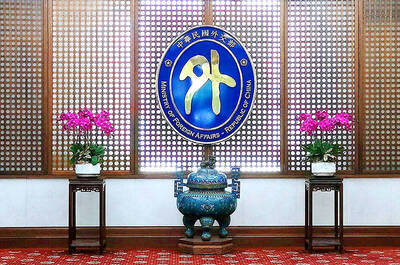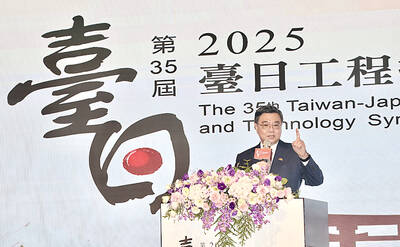Questions emerged at the weekend as to whether Taiwan could afford both a multibillion-dollar upgrade program for its F-16A/B combat aircraft and new F-16C/Ds, amid claims that the price for the upgrade had been inflated since the deal was announced last year.
The air force received a Letter of Answer from the US last week on the US$5.3 billion upgrade package for its 145 F-16A/Bs and is now reviewing the prices of the items on the list, Air Force Command Headquarters said yesterday.
“We will sign an agreement on the deal only after we have completed an overall review and have determined that all the items meet our requirements or demands,” it said in a statement.

Photo: Yu Tai-lang, Taipei Times
About one week before the letter was received, Washington said it would give “serious consideration” to long-stalled efforts by Taipei to acquire 66 F-16C/Ds. A notification to the US Congress in September last year approved the upgrade package, but did not include the new aircraft.
The possibility that the US could agree to upgrade the F-16A/Bs and release the F-16C/Ds might now force the cash-strapped ministry to make a difficult choice. Since 2008, the US has agreed to about US$13 billion in arms sales to Taiwan, which has also embarked on a costly effort to adopt a fully professional military system by 2015.
In an article published on Saturday, Defense News said the US Air Force had been pressuring Taiwan to pay for nonrecurring engineering (NRE) costs related to the research, development, testing and integration of the Active Electronically Scanned Array (AESA) radar, a key component of the upgrade package. The article said those costs were not included in the September notification.
An unnamed consultant for the ministry told the magazine that Taiwan was “getting a raw deal” from the US, because the additional money Taiwan would need to spend on NRE costs would “break the bank.”
The same day, Chinese Nationalist Party (KMT) Legislator Lin Yu-fang (林郁方) said the additional NRE costs could make the upgrades more expensive than acquiring new F-16C/Ds.
Preliminary negotiations have already been conducted and the Taiwanese air force is of the opinion that the US price is too high and the government’s finances will simply not stretch that far, Lin said.
The air force yesterday denied that the price for the upgrade package had been inflated, but declined to specify the amount of the deal.
A defense sources told the Taipei Times earlier this year that Taipei could avoid the NRE costs by waiting for South Korea to decide which type of AESA radar it would adopt as part of the upgrade program for its 135 KF-16C/Ds. Two firms, Raytheon Corp and Northrop Grumman Corp, are bidding for the AESA program and Seoul is expected to make its decision this month or next month.
The US Air Force, which is also scheduled to upgrade 350 of its F-16s, could save money by having other countries, such as Taiwan or South Korea, pay for the NRE costs.
In February, the Executive Yuan informed the air force that it would only allow US$3.7 billion for the upgrade program. While the military insists on acquiring the AESA radar, it could lower the cost by opting not to acquire some of the items included in the notification, such as certain types of Joint Direct Attack Munitions (JDAM) kits.
The letter received last week is said to have reflected the US$3.7 billion ceiling set by the Executive Yuan after Taiwan negotiated for the removal of items it did not seek to acquire.
Deputy Minister of National Defense Andrew Yang (楊念祖) told the legislature on Saturday that if the capabilities of the F-16C/Ds were no better than those of the F-16A/Bs following the upgrade, the military could consider not purchasing the new aircraft.
Clarifying Yang’s remarks, ministry spokesman Major General David Lo (羅紹和) said the air force was preparing to upgrade its -F-16A/Bs and that the capabilities of any future purchases made by the air force would have to surpass those of the F-16A/B.
Yang’s comments were based on practicality and were not a conditional requirement, Lo said.
Additional reporting by CNA
translation by Jake Chung, Staff Writer

The Ministry of Foreign Affairs (MOFA) yesterday voiced dissatisfaction with the Comprehensive and Progressive Agreement for Trans- Pacific Partnership (CPTPP), whose latest meeting, concluded earlier the same day, appeared not to address the country’s application. In a statement, MOFA said the CPTPP commission had "once again failed to fairly process Taiwan’s application," attributing the inaction to the bloc’s "succumbing to political pressure," without elaborating. Taiwan submitted its CPTPP application under the name "Separate Customs Territory of Taiwan, Penghu, Kinmen and Matsu" on Sept. 22, 2021 -- less than a week after China

ALIGNED THINKING: Taiwan and Japan have a mutual interest in trade, culture and engineering, and can work together for stability, Cho Jung-tai said Taiwan and Japan are two like-minded countries willing to work together to form a “safety barrier” in the Indo-Pacific region, Premier Cho Jung-tai (卓榮泰) yesterday said at the opening ceremony of the 35th Taiwan-Japan Modern Engineering and Technology Symposium in Taipei. Taiwan and Japan are close geographically and closer emotionally, he added. Citing the overflowing of a barrier lake in the Mataian River (馬太鞍溪) in September, Cho said the submersible water level sensors given by Japan during the disaster helped Taiwan monitor the lake’s water levels more accurately. Japan also provided a lot of vaccines early in the outbreak of the COVID-19 pandemic,

THE GOOD WORD: More than 100 colleges on both sides of the Pacific will work together to bring students to Taiwan so they can learn Mandarin where it is spoken A total of 102 universities from Taiwan and the US are collaborating in a push to promote Taiwan as the first-choice place to learn Mandarin, with seven Mandarin learning centers stood up in the US to train and support teachers, the Foundation for International Cooperation in Higher Education of Taiwan (FICHET) said. At the annual convention of the American Council on the Teaching of Foreign Languages held over the weekend in New Orleans, Louisiana, a Taiwan Pavilion was jointly run by 17 representative teams from the FICHET, the Overseas Community Affairs Council, the Steering Committee for the Test of Proficiency-Huayu, the

A home-style restaurant opened by a Taiwanese woman in Quezon City in Metro Manila has been featured in the first-ever Michelin Guide honoring exceptional restaurants in the Philippines. The restaurant, Fong Wei Wu (豐味屋), was one of 74 eateries to receive a “Michelin Selected” honor in the guide, while one restaurant received two Michelin stars, eight received one star and 25 were awarded a “Bib Gourmand.” The guide, which was limited to restaurants in Metro Manila and Cebu, was published on Oct. 30. In an interview, Feng Wei Wu’s owner and chef, Linda, said that as a restaurateur in her 60s, receiving an